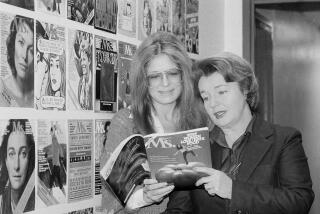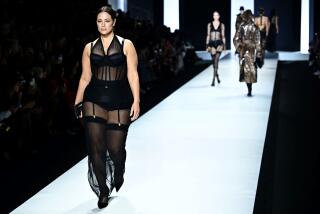Plus-Size Magazine Is in Success Mode
- Share via
Since its debut last March, Mode magazine, offering fashion and beauty for plus-size women, has gotten--forgive the pun--bigger.
Its starting circulation of 250,000 is up to 360,000 now, and its quarterly status will change to 10 issues a year beginning next March, a year ahead of schedule.
Publication directors Nancy Nadler LeWinter and Julie Lewit-Nirenberg couldn’t be happier with the publication’s progress and feedback from readers.
“What surprised Nancy and I,” said Lewit-Nirenberg, the former publisher of New York Woman, Mirabella and Mademoiselle, “is the kind of passion women are responding with, along the lines of, ‘You’ve changed my life,’ which is something we don’t expect a magazine to do.”
The two brainstormed the concept after seeing statistics showing that despite the country’s never-ending diet obsessions, people were getting larger. The time seemed right to do a slick women’s fashion magazine: Designers such as Liz Claiborne, David Dart, Dana Buchman, Ellen Tracy and Emanuel Ungaro were filling a growing demand for chic clothes in size 14 and beyond, and department stores were no longer relegating these collections to the basement. They also were aware of a brewing backlash against magazines featuring waif-like, teenage models.
Since the magazine’s launch, LeWinter and Lewit-Nirenberg have noticed changes: More plus-size models are signing up with agencies, and clothing labels such as Anne Klein have entered the market.
Still, not all barriers have been obliterated. LeWinter, former director of Vogue and Glamour and publisher of Esquire, reports that some zaftig celebrities have resisted being profile subjects. “We don’t know what impact it will have in terms of what roles they get. But some aren’t embarrassed about it.”
The New York-based magazine continues to discuss attitudes about weight and size. The winter 1997 issue, featuring popular large-size model Emme on the cover, has an essay on women’s feelings toward their bellies, plus Gael Greene’s exploration on why it’s considered verboten to chow down in front of your lover.
Despite Mode’s acceptance, neither partner believes that any traditional fashion magazines will integrate larger sizes on a regular basis. “I think that will be the case for a good time to come,” said LeWinter. “They’ll still see it as tainting their fashionable image. Even some designers won’t advertise their full-figured lines because they don’t want to hurt their missy image.”






